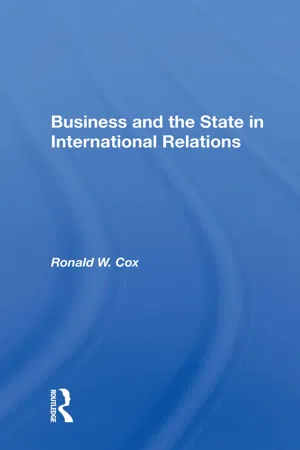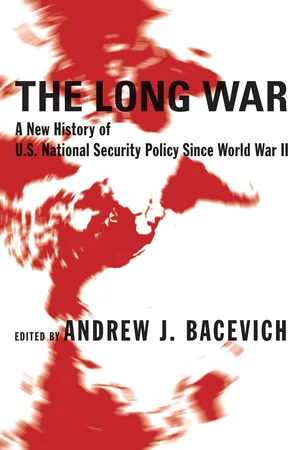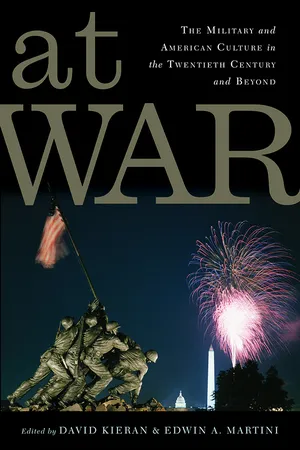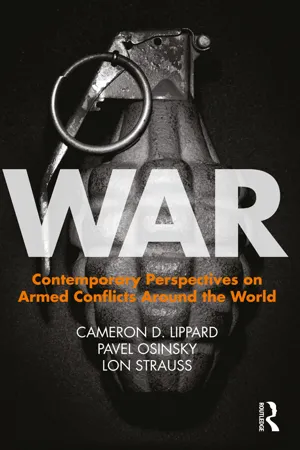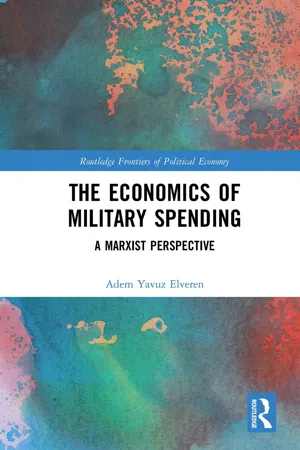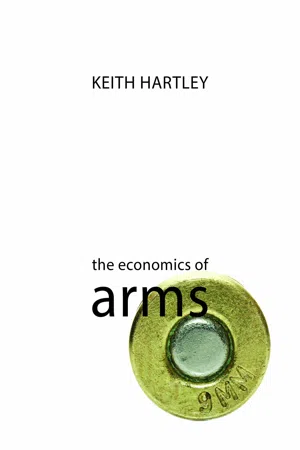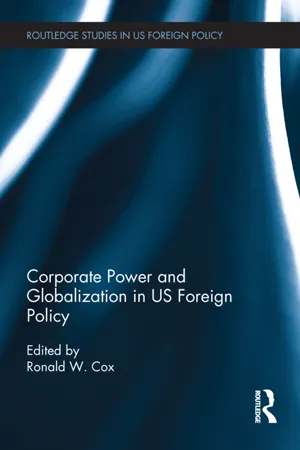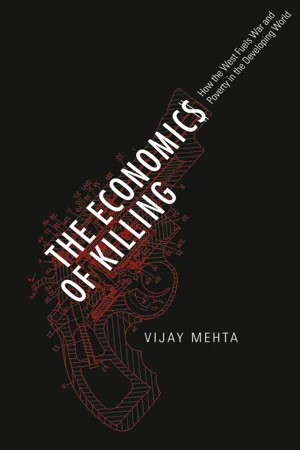History
Military-Industrial Complex
The term "Military-Industrial Complex" refers to the close relationship between the military and defense industry, where the interests of both sectors become intertwined. This concept gained prominence in the United States during the Cold War era, highlighting the potential influence of defense contractors on government policy and military spending. The term is often used to critique the potential negative impact of this relationship on national priorities and spending.
Written by Perlego with AI-assistance
Related key terms
Related key terms
1 of 4
Related key terms
1 of 3
10 Key excerpts on "Military-Industrial Complex"
- Ronald W Cox(Author)
- 2019(Publication Date)
- Routledge(Publisher)
The Military-Industrial Complex, Sectoral Conflict, and the Study of U.S. Foreign PolicyDavid Ν. GibbsBureaus have an inherent tendency to expand, regardless of whether or not there is any genuine need for more of their services. In fact, all organizations have inherent tendencies to expand.—Anthony Downs, Inside BureaucracyThe defense establishment now devotes a large share of its efforts to self perpetuation. ... War justifies the existence of the establishment. ...—General David M. Shoup, Former commandant, United States Marine Corps, "The New American Militarism"Standing closely behind these [military] leaders, encouraging and prompting them, are the rich and powerful defense industries. Standing in front, adorned with service caps, ribbons, and lapel emblems, is a nation of veterans—patriotic, belligerent, romantic, and well intentioned, finding a certain sublimation and excitement in their country's latest military venture.The Military-Industrial Complex is a very healthy thing. —Elbridge Durbrow, Vice Chairman, American Security CouncilThe question of the Military-Industrial Complex provides an interesting case in the sociology of knowledge. During the 1960s and 1970s, scholars directed considerable attention toward the phenomenon of military-industrial linkages, and numerous titles contained the phrase "Military-Industrial Complex." The attention to this approach was, at least to some extent, correlated with a loss of prestige by the military and, indeed, the entire executive branch of government, due to the Vietnam War, the Watergate scandal, the Church Committee hearings on the CIA (Central Intelligence Agency), and other memorable events of that period. Much of the writing on the Military-Industrial Complex was polemical and journalistic, but there were also serious empirical studies, which tested the approach under controlled conditions. Some well-known and respected political scientists and economists, including Murray Weidenbaum, Samuel Huntington, Robert Art, Bruce Russett, and James Kurth, published research on the subject.1 In 1973, Steven Rosen concluded that, despite some contrary findings, "it is remarkable how well it [the Military-Industrial Complex approach] has withstood critical evaluation, some of it from an obviously skeptical perspective. ... We conclude that the theory of the Military-Industrial Complex is a most useful analytical construct for both research and policy evaluation purposes."2- eBook - ePub
The Long War
A New History of U.S. National Security Policy Since World War II
- Andrew Bacevich(Author)
- 2007(Publication Date)
- Columbia University Press(Publisher)
8. THE Military-Industrial Complex LOBBY AND TROPEALEX ROLANDThe Military-Industrial Complex was both a historical phenomenon and a political trope. The phenomenon was a lobby that campaigned intensely in the United States to promote increased military spending and arms production. It flourished for a quarter of a century during the Cold War. The trope gained currency in the antiwar movement of the Vietnam era. It, too, is best understood in a Cold-War context.1Both meanings of the term are captured by the Oxford English Dictionary. It defines “military industrial” as(orig. U.S.), of or relating to a nation’s armed forces and to its industries (esp. those producing military equipment); esp. in Military-Industrial Complex (orig. and chiefly U.S.), these resources as a whole, regarded as a powerful vested interest and a strong influence on government.The fourth edition of the American Heritage Dictionary of the English Language presents another meaning that has grown up around the term:the aggregate of a nation’s armed forces and the industries that supply their equipment, materials, and armaments.It is in this guise that Military-Industrial Complexes have been sighted on every continent and as far back in history as the Middle Ages. This essay will focus on the first two meanings, a lobby and a trope, which reflect America’s experience of the Cold War.THE WARNINGPresident Dwight Eisenhower introduced the “Military-Industrial Complex” in his farewell address to the nation on January 17, 1961. His speech-writer, Malcom Moos, coined the term to capture what Eisenhower called in private the “delta of power.”2 - eBook - ePub
At War
The Military and American Culture in the Twentieth Century and Beyond
- David Kieran, Edwin A. Martini(Authors)
- 2018(Publication Date)
- Rutgers University Press(Publisher)
Half a century later, the phrase “Military-Industrial Complex” may be less commonly heard, but it is hardly gone. In recent years we have been introduced to new variants of the phrase, including the “medical-industrial complex” and the “prison-industrial complex.” These new “complexes” are important, but their ascendance should not blind us to the continuing significance of the original one. The United States, as it maintains the most powerful military forces in the twenty-first-century world, continues to spend enormous resources on defense. These outlays, which had dipped during the post Cold War decade of the 1990s, grew significantly in the opening years of the twenty-first century, as the United States responded to the 9/11 attacks with military operations in Afghanistan and Iraq, as well as larger investments in “homeland security.” In other words, Eisenhower’s Military-Industrial Complex appears to be an enduring and resilient institution. It still carries very high costs; it affects the lives of millions of people (and has the potential to affect the lives of billions), at home and abroad. For all of these reasons, today’s students of war and society have good reason to give it their attention.What is meant by the phrase “Military-Industrial Complex”? To some extent, it serves simply as a lively synonym for the defense sector or the armaments industry. That is, it refers to the networks of producers, sellers, promoters, and consumers of the goods and services required by armed forces. Thus the companies and workers making things like submarines and missiles are part of the Military-Industrial Complex, as are the military agencies purchasing them. But “Military-Industrial Complex” is not just a value-neutral synonym for defense sector. More often than not, it is a pejorative term, meant to imply that the modern defense sector, at least as it has developed in the United States since 1945, is a dangerous monster that benefits special interests while harming the public good. In his 1961 farewell address, Eisenhower pointed to both of these definitions—the more neutral one and the more negative. No radical pacifist, Eisenhower regarded the defense sector as necessary. At the same time, he warned that it might become too powerful, too wasteful, and too damaging to the best traditions of American capitalism and democracy. Since the 1960s, this warned-of “Military-Industrial Complex,” which Eisenhower suggested was a possible future evil to be avoided, is what is most often suggested by those who use the term.However it may be defined, the Military-Industrial Complex, despite its importance, is not very well understood by scholars and the public.1 - eBook - ePub
Why War
Capitalism and the Nation-State
- Simon Stander(Author)
- 2014(Publication Date)
- Bloomsbury Academic(Publisher)
7 Military–Industrial Complexes IntroductionThe outstanding feature of many advanced economies lies in the permanent development, continuous technological innovation, research and production of arms of all kinds to be used by all branches of the armed services. The system, especially marked in the UK, the USA, France, Germany, Italy, the Netherlands, Spain, China, Russia and Israel as well as in existence in India and Brazil, is a continuation of the tendency that began in Europe for the export of arms worldwide based on a strong domestic production which is now known as the military–industrial complex. Nothing illustrates the way in which Europe and the USA have spread war around the globe than the history and current state of military–industrial complexes. This tendency is not so much a matter of defence though defence issues do have their role. It was Adam Smith, in justifying limited government expenditure, who asserted that ‘defence comes before opulence’. On the other hand, a large part of the motivation for the export of arms and their production is driven by the profit motive, and the intervention of the nation-state in the name of national interest and/or defence confirms the prospect of a permanently irremovable element in the modern mix that guarantees there will be wars somewhere or other on the planet day to day. This chapter looks at the military–industrial complex as in the USA and in the UK as well as Israel though, of course, there are many others.It is commonly acknowledged that the origin of the term, as we now understand it, lies in the farewell speech Dwight Eisenhower made to the people of the USA after eight years of his Republican presidency in January 1961. However, there is much more to the speech than the mere coining of the phrase which has now been extended in the context of the USA to including the role of government (military–industrial–congressional complex). At first sight it seems slightly surprising that a former general and two-term Republican president of the USA should seemingly warn against the danger of the tight and possibly indissoluble marriage of the military and of large corporations. However, we see deeper in the speech a reference to the necessity of this marriage. ‘A vital element in keeping the peace is our military establishment. Our arms must be mighty, ready for instant action, so that no potential aggressor may be tempted to risk his own destruction.’ This is a clear reference not merely to conventional arms but to the nuclear arsenal that must always be kept ready for use. He also saw the economic and employment importance of the arms industry by referring to its size. ‘Three and a half million men and women are directly engaged in the defense establishment. We annually spend on military security more than the net income of all United States corporations.’ Eisenhower sees the downside of this in many respects when he goes on to say: - eBook - ePub
War
Contemporary Perspectives on Armed Conflicts around the World
- Cameron D. Lippard, Pavel Osinsky, Lon Strauss(Authors)
- 2018(Publication Date)
- Routledge(Publisher)
To sum up, in the twenty-first century, the American Military-Industrial Complex has transformed into the globalized security system that outsources its functions to numerous contractors and subcontractors and that no longer recognizes the sovereignty or concerns of other nations. It also has little concern about the legal or ethical aspects of its operations. It is a vast computerized system whose power relies on collecting, processing, and storing the huge amount of information about the lives of millions of people around the world. Right now, the system continues to expand as the new gigantic information storage facilities are being built in various places on U.S. territory. Unless concerned citizens establish democratic control over the system, it will turn completely impenetrable to society. In the nearest future, it can become thoroughly automatic, so that detecting and fighting the enemies of the system, real or imagined, could be done by computers and robots, and would not require a human effort.Discussion Questions
- What is the Military-Industrial Complex? Specifically, how does it work to perpetuate warfare in the modern era?
- What were the transformations that prepared the grounds for the emergence of the Military-Industrial Complex and the advent of the total war?
- What is a command economy and how does it shape political relations and warfare?
- What three factors shaped and cemented the existence of the American national security state?
- In the United States, how has the Military-Industrial Complex changed in the twenty-first century?
References
Adams, Gordon. 1981. Politics of Defense Contracting: The Iron Triangle . New Brunswick, NJ: Transaction Books.Bacevich, Andrew J. 2013. The New American Militarism: How Americans Are Seduced by War . Oxford: Oxford University Press.Barber, John, and Mark Harrison. 1991. The Soviet Home Front, 1941-1945: A Social and Economic History of the USSR in World War II . London: Longman.Brooks, Rosa. 2016. How Everything Became War and the Military Became Everything: Tales from the Pentagon . New York: Simon & Schuster.Chatterjee, Pratap. 2009. Halliburton’s Army: How a Well-Connected Texas Oil Company Revolutionized the Way America Makes War . New York: Nation Books.Eitzen, D. Stanley, Maxine Baca Zinn, and Kelly Eitzen Smith. 2014. Social Problems . 13th Edition. Boston: Pearson.Ellis, John. 1986. The Social History of the Machine Gun . Baltimore: Johns Hopkins University Press.Haass, Richard N. 1997. The Reluctant Sheriff: The United States after the Cold War - eBook - ePub
The Economics of Military Spending
A Marxist Perspective
- Adem Yavuz Elveren(Author)
- 2019(Publication Date)
- Routledge(Publisher)
3 Military Keynesianism and the Military-Industrial Complex Introduction Military Keynesianism, which is the policy of using milex as a counter-cyclical economic tool, suffers from a lack of theoretical sophistication (Dunne, 2013). That is, it has no clear theory; rather, milex is simply considered as one component of government spending. From a long-run perspective, the dynamics of milex is explained through Military-Industrial Complex (MIC) theory. It is essential to understand the role of the U.S. in the current world, as it undertakes the great bulk of milex in the capitalist system. Therefore, below I attempt to provide a brief discussion of the MIC and Military Keynesianism. The root of the term Military-Industrial Complex goes back to the writings of C. Wright Mills (1956), although it first became popular with President Dwight Eisenhower’s well-known farewell address in 1961, when he described a new kind of threat: [W]e can no longer risk emergency improvisation of national defense; we have been compelled to create a permanent armaments industry of vast proportions. Added to this, three and a half million men and women are directly engaged in the defense establishment. We annually spend on military security more than the net income of all United States corporations. This conjunction of an immense military establishment and a large arms industry is new in the American experience …. [W]e must not fail to comprehend its grave implications. Our toil, resources and livelihood are all involved; so is the very structure of our society. In the councils of government, we must guard against the acquisition of unwarranted influence, whether sought or unsought, by the military industrial complex. The potential for the disastrous rise of misplaced power exists and will persist. We must never let the weight of this combination endanger our liberties or democratic processes… - eBook - ePub
- Keith Hartley(Author)
- 2017(Publication Date)
- Agenda Publishing(Publisher)
8 THE MILITARY–INDUSTRIAL–POLITICAL COMPLEX IntroductionArms industries are often condemned for being part of a powerful military–industrial complex that determines arms decisions. Is this a figment of the imagination or a real feature of arms industries? Developments in the economics of politics and public choice analysis provide valuable insights into understanding this complex.The term is associated with President Eisenhower’s farewell address in January 1961, when he referred to the need for society to “guard against the acquisition of unwarranted influence … by the military–industrial complex”, adding that “the potential for the disastrous rise of misplaced power exists and will persist” (Eisenhower 1961). The political component has been added to the description military–industrial complex to recognize the role of political markets within the complex. Political markets comprise governments, political parties, bureaucracies and various other interest groups consisting of producers, consumers, and the disarmament, peace, environmental and green movements. This approach departs from the traditional economic model of competitive markets assuming large numbers of buyers and sellers. Instead, arms industries operate in political markets where the government is the only or major buyer and where there are often monopoly or oligopoly suppliers with barriers to new entry and markets typically in disequilibrium rather than achieving some neat mathematical and theoretical equilibrium. A further political dimension arises where arms producers are state owned rather than privately owned. The result of arms industries operating in political markets is that we need to use public choice analysis to further understand and explain behaviour in such markets. - Ronald Cox, Ronald W. Cox(Authors)
- 2012(Publication Date)
- Routledge(Publisher)
Evidently, corporate support for the MIC extends well beyond the armaments industry, and such broad business support enhances the MIC’s overall influence. This point can be illustrated by recent military policy: There can be no doubt that political pressures emanating from oil companies influenced both US and British interventions in the Persian Gulf (a point underscored by the release of UK government documents on this topic, see Bignell 2011). Investors also may benefit from paramilitary covert operations conducted by the Central Intelligence Agency. It is clear that certain covert operations have been undertaken with strong support from affected investment interests, including such cases as the Standard group of oil companies with regard to the 1953 covert operation in Iran (Kwitny 1984); the United Fruit Company with regard to the 1954 operation in Guatemala (Schlesinger and Kinzer 2005); and a range of mining interests with regard to 1960–1963 operations in the Congo (Gibbs 1991).Thus, we have seen that the influence of the military–industrial complex on national policy rests on three main pillars: the direct lobbying of the private sector arms manufacturers, the armed services, and other government agencies that are closely tied to the services; the general enthusiasm among presidents and executive-level officials for military spending, as a device for economic planning; and the support for military strength found in nonmilitary sectors of the business elite, notably among those sectors that seek to use the US military for the protection or expansion of overseas investments. Although the focus of this chapter has been on the United States, there is no reason to confine this analysis to any one country. The MIC approach would be applicable to any country with a large military force combined with a military manufacturing capability, such as Russia, China, India, France, Great Britain, or Israel.Let us now consider how globalization affects the military–industrial complex. Traditionally one thinks of military industries as among the most nationalistic of economic sectors, as most countries will be unwilling to trust “outsiders,” even among military allies, with such sensitive matters as the production of weaponry. In spite of this tendency, arms manufacturing has been globalized to some degree, as countries collaborate in weapons production, to achieve economies of scale and reduce research and development costs. This has been especially true in Europe, notably in aerospace and related sectors. Since the late 1960s, many of the leading fighter planes produced by European states have been multinational ventures, including the Sepecat Jaguar, the Panavia Tornado, and the Eurofighter Typhoon. The 1999 advent of the European Aeronautics, Defence, and Space company (EADS) was a major advance in the globalization of the military–industrial complex. Now based in the Netherlands, EADS was created as a merger of Spanish, French, and German aerospace companies. It is also integrated with American capital through Daimler-Chrysler, which owns stock in EADS (for a survey see The Economist 2002). The past decade has seen further globalization of military production, with significant and increasing integration between the European and US military sectors (see Anderson 2010; and Anderson and Wagstaff-Smith 2010); as well as efforts by both the Europeans and Americans to integrate with the Indian MIC (see Harrington 2007). In the words Aviation Week- eBook - ePub
Democratic Transformations
Eight Conflicts in the Negotiation of American Identity
- Kerry T. Burch(Author)
- 2012(Publication Date)
- Continuum(Publisher)
CHAPTER SEVEN The Military-Industrial ComplexP erhaps no other piece of public rhetoric in circulation today has attained greater iconic status within the nation’s political lexicon than Dwight Eisenhower’s educationally pregnant phrase, the Military-Industrial Complex (MIC).1 First identified in his 1961 farewell address, President Eisenhower described the MIC as a seemingly intractable problem that carried with it a set of “grave implications.” Surely then it’s a good thing that today, 50 years later, increasing numbers of Americans are familiar with the phrase. What is less evident is whether this general familiarity translates into a full appreciation of the phrase’s stunning political, educational, and even gendered implications. The purpose of this chapter is to investigate these implications and to suggest how the phrase might be recruited to serve as a meaningful piece of democratic rhetoric, one that can be mined pedagogically to heighten awareness of militarization as a threat to America’s democratic identity.In his final speech-act as chief executive, Eisenhower informed the nation about the ominous presence of a new “conjunction” of power between the government’s military establishment and private arms industries—what he called the “Military-Industrial Complex.” His message contained not only a warning but also a rare official critique of an emerging civic conundrum: that while the military may be needed to defend the nation, it should not come to define it. This core tension, or dread possibility, is what animates Eisenhower’s Cold War jeremiad. Remarkably enough, instead of asking his fellow Americans to fear the Russians above all else, as might be expected in that anxious and fearful phase of the Cold War, Eisenhower asked Americans to fear a new source of internal danger.We have been compelled to create a permanent armaments industry of vast proportions . . . We annually spend on military security alone more than the net income of all United States corporations. Now this conjunction of an immense military establishment and a large arms industry is new in the American experience. The total influence—economic, political, even spiritual —is felt in every city, every statehouse, every office of federal government. We recognize the imperative need for this development. Yet we must not fail to comprehend its grave implications. In the councils of government, we must guard against the acquisition of unwarranted influence, whether sought or unsought, by the Military-Industrial Complex. (My emphasis)2 - eBook - ePub
The Economics of Killing
How the West Fuels War and Poverty in the Developing World
- Vijay Mehta(Author)
- 2012(Publication Date)
- Pluto Press(Publisher)
2 What is the Military-Industrial Complex?In 1921, 30 years before Eisenhower gave his speech, Vladimir Illych Lenin, the leader of Soviet Russia, unveiled his New Economic Policy, the Novaya Ekonomicheskaya Politika. The policy laid out a blueprint for a dialled-back form of communism. Instead of the government running every aspect of commerce, the state would instead relinquish control of all but the ‘commanding heights’ of the economy.1 These heights were defined as major industries such as energy, steel, banking and heavy manufacturing, as these were viewed as the sectors that controlled the rest of the economy. They were to be organised by the Soviet government’s Council of Labour and Defence.Ninety years on, Lenin might have been surprised to note the similarities between his model and the economy that now exists in the US. The 2008 financial crisis demonstrated that American financial institutions, far from being bastions of capitalism, enjoyed an implicit government guarantee that saw them bailed out to the tune of hundreds of billions of dollars. It became a truism to say that while the banks’ profits were privatised, their risks were socialised. Nor was the nationalisation of these risks a left-wing endeavour. The rescue was ordered by the Republican administration of President George W. Bush.Heavy industry, another of Lenin’s ‘commanding heights’, could also count on taxpayer support. In 2008 US car manufacturers received a $25 billion credit line from the Bush administration to develop cleaner cars, at a cost of $7.5 billion to taxpayers.2 Under President Barack Obama the government provided a further $60 billion, thus becoming the majority shareholder in General Motors.3 These sums do not include the government’s ‘cash for clunkers’ scheme, which bribed US consumers to purchase new cars at a cost to the taxpayer of several billion more dollars.4
Index pages curate the most relevant extracts from our library of academic textbooks. They’ve been created using an in-house natural language model (NLM), each adding context and meaning to key research topics.
Explore more topic indexes
Explore more topic indexes
1 of 6
Explore more topic indexes
1 of 4
